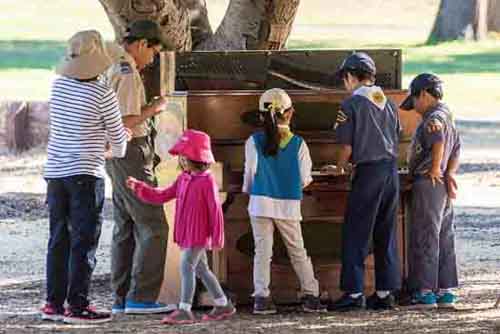I most often worked with the Alfred All-in-One series for younger beginners for the “book portion” of the lessons, and usually found it to provide an effective foundation for reading. I have found that lots of repetition and explanation with the occasional redirection, and a well written lesson plan for both parents and students to follow is usually the key to optimize working with any student under age six.
The following is a basic outline (not necessarily exactly in this order, but in general it seems to work well). You will have to go back and revisit many of these things often during the lesson to make sure they sink in. Some of them may take a long time for some of the youngest students, perhaps weeks or even months, and that's ok. Just keep going over it at each lesson.
- find the groups of two and 3 black keys
- find the group of two black keys in the middle
- distinguish the right hand from left hand
- find middle C
- find middle C scale position with right hand
- 5 note C scale with right hand (slowly)
- hear the difference between high and low notes
- 5 note C scale with Right hand 3x in a row
- attempt C chord (open 5th at first, then when ready make a "spider" with your hand for the full chord. This may take a while--keep trying at every lesson.)
- learn all finger numbers with Right and Left Hand--(you can use the page in the book to illustrate this) and quiz by holding up or pointing to--"which is your RH 2nd finger", etc.
- 5 note C scale with Left hand (C below middle C - 3x in a row when ready)
- 5 note C chord with Left hand
- play some music for listening (you can do this at any time to get attention, and then go back to one of the previous things you were working on) - teach fast/slow, loud/soft (not TOO loud of course--just enough to make the point), hi/low, happy/sad (major/minor)
- start working in book, very slowly, and review often
- add other scales (5 notes slowly, both hands separately) and chords (both hand seperately)
- once they get past C, G, D, A scales, you can try both hands together on C (this could take a long time)
- after first few songs become easy in the book, start rhythm exercises with metronome (If they can't do it at first, let it go & come back and try it again at the next lesson. Some will get close immediately, some NEVER will. The goal is just to improve whatever their natural ability is.)
- try to add metronome with scales (not too fast, around 60BPM is good)
- eventually the goal is to know all 5 note scales and triad chords (may take years for some)
In general as lessons progress, I usually start the lesson plan with 5 note scales or partial scales to both strengthen fingers and provide piano theory (with a metronome once the student has the ability), then chord studies (all 3 voice Major, minor, for older students eventually progressing on to 4 voice, etc), then studies in the lesson book (again using metronome whenever possible), and then ear training (if there's time and if the student has done the other homework). Of course every teacher has his or her own methods, and I am very appreciative of that. I hope this information helps.
Photo Credit: Don DeBold




